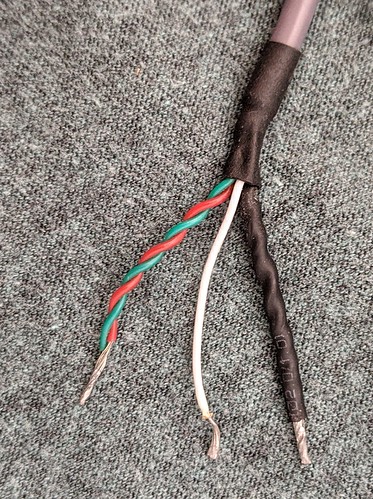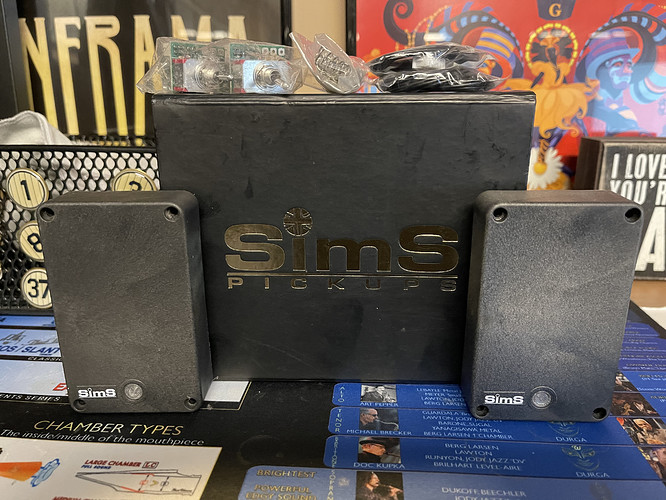Yeah, I keep it in my cart, in case I get some quick cash, or somebody wants to get it for me. LOL
Sounds perfectly reasonable @T_dub 
That is GREEN. I love it. What paints and clearcoats are you using?
If you want to help it along and you are using water-based paints/clearcoats, you can stick it in your oven and turn on the oven light (JUST the oven light) and stick a bag of dry rice in there (about 4 lbs or so). If you want to be really fancy, tape the door of the oven shut. That will put the temperature up to ca. 30 degrees or so, increase the moisture capacity of the air. The rice will absorb lots of moisture as well.
Saddle update:
Remedial measures performed. I chased all the tapped holes with an M3x0.5 tap, and the screws with an M3x0.5 die.
The problem was that the bridge and saddles were chromed after machining. There was just a ton of chrome overflow in all the holes stopping the screws from working as they should.
The limited saddle travel is a problem, but I won’t shorten the screws until I know my bridge placement. For that I need the body and neck to arrive. Stay tuned.
Looking good @Mac,
love the spray booth 


Cheers Brian
So I had a “finger through the toilet paper while wiping “ day 
Thought I would polish the Flying V today and then maybe begin to assemble it.
All initially went well until I noticed a finger mark in the finish ! Closer inspection revealed several more not only on the body of the bass but also the headstock. The clear coat should have been dry , I should have noticed a sludge buildup on the wet/dry paper ( still can’t see it) but it wasn’t to be and I’m looking at stripping the paint and starting again 
To add a little more pain to the situation I managed to bounce the fly screen door off of the bass body and leave two nice dings in it.
And then I realised that among all the stuff I had laid out in front of me I was missing the basses pickups!
I’ve now spent the rest of the evening tearing the house apart but to no avail.
I’m now thinking I might have thrown them out with the box.
I’m consoling myself with a large tub of ice cream and considering my options
I almost fell off my chair after reading this. ![]()
![]()
![]()
![]()
![]()
![]()
This sounds very familiar, I have lost countless things that about the only explanation is they were thrown out by me or another in the house.
Yikes.
What your shop needs, what ALL shops need is a “moaning chair”. This is an actual chair in the corner of the workshop. When you make a major SNAFU in your project, you then sit in the chair with your hand in your mouth rocking back and forth making “mmm, mmmmm, mmmm” noises. You do this until you figure out a way to fix the problem. Also, it’s imperative that the chair is not a rocking chair, but preferably and old, chipped plywood on a tube steel frame one in institutional green 
The paint is a pain, especially when you live in a humid climate. Are you located somewhere in Queensland? I remember Brisbane and Cairns being humid when I was there, but not the south so much. We get horrible humidity here as well, not as bad as Toronto, but I’m in S/W Ontario smack, dab in the middle between the Great Lakes. I feel your pain.
FWIW
How many layers do you have on it? We’ll see how well I do with my own bass project, but I’ve built a cabinet that I ended up clearcoating 15 times with super fine layers. The upshot is that you also get a much nicer finish in the end, though it is a pain in the fundament to do.
As an alternative to try, if you have a test piece on the side (TEST piece  not the Green V of Doom right away!) and you’re using a water-based polyurethane or acrylic clearcoat you could try to thin it down with some methanol (30 - 70% final concentration) and put it on with either a fine foam roller or spray it on. Adding a little (1-2% final concentration) glycerin or propyl glycol will help the flow. You’d need to give it a quick and gentle sanding with a fine paper (800 or so) between coats. The methanol will help the drying, just don’t breathe it too much.
not the Green V of Doom right away!) and you’re using a water-based polyurethane or acrylic clearcoat you could try to thin it down with some methanol (30 - 70% final concentration) and put it on with either a fine foam roller or spray it on. Adding a little (1-2% final concentration) glycerin or propyl glycol will help the flow. You’d need to give it a quick and gentle sanding with a fine paper (800 or so) between coats. The methanol will help the drying, just don’t breathe it too much.
In terms of the pickups: have you tried contacting the kit maker? Maybe they just missed them in the kit? Or else they may be able to replace them for a minor consideration?
Good one, Mac ![]()
Sorry to hear about your problem with the paint job! On the bright side, you probably have learned something and won’t make that mistake again!?!
A moaning chair is a great idea although a punch bag would have been more use yesterday @MC-Canadastan.
Thanks for the tips too. I’m in Melbourne but the humidity here is all over the place ( 25 % to 95%). Certainly makes painting interesting.
I put a fair few layers of clear on very sparsely and to be honest I was really pleased with the results.
The order of the day after getting the results of my hospital appointment seems to involve the purchase of a good few sheets of different grades of sandpaper 
You’re quite right @joergkutter. I learnt a valuable lesson. I’ll stick to oiling my basses. At least until the summer months anyway and as always, patience is a virtue.
The carnage continues, call it a bass explosion in reverse. The parts are accreting in my workshop. However, I have a question to pose to you good folks, and by good folks I mean those of an electronic disposition. In case you haven’t noticed, I’m more of the mechanical/metal and wood working type. Paging you, Dr. @terb !!
I received my preamp and pickups yesterday.
The preamp is a generic active 3 band jobby (pure Grade A Chinesium from Big Rock Candy Mountain), treble-mid-low, volume and blend + jack.
The pups are generic active MM clones with ceramic pole pieces ( also pure Grade A Chinesium from Big Rock Candy Mountain).
The original setup I wanted to do was to use a stacked 2x3 position rotary switch to wire each pup single coil-parallel-serial and then to feed from the switch into the preamp.
However, not all pups are equal, and the ones I got came with absolutely no wiring diagram, nor has the seller sent me one in the two weeks since I asked for one. I have to check whether I can wire these pups in the 3 coil configurations, or whether I have to use serial or parallel mode permanently. What would be the testing procedure for this? I have a power supply and a very sensitive multimeter.
EDIT: I forgot to mention that they’re potted in silastic, so there’s no way to trace the wires visually.
EDIT 3: It’s not silastic. It’s f**ng hot snot 
Also: because it’s a ceramic pup, the pots are what they are, and the body of the bass will be maple, I expect it to be quite trebly (which is what I wanted, but there are limits). Thus, I want to put a tone cap on right off the bat. I have a 0.047mf and a 0.033. Which one would you recommend to start with and which pot would it be best to go with, volume or treble?
EDIT 2: Here are pictures of the wire and the back of the pup.
I like the way you put that, @MC-Canadastan . . . ![]()
Cheers and good luck with your project,
Joe
Not my terminology, ™ by my favorite youtuber: AvE but I think they are so apt ![]()
Any electronic Wizzards*? Please, as per the question above?
*™ Terry Pratchett
Is that like Living on a Chinese Rock?
Big Rock Candy Mountain = Shenzen City, China
The world’s warehouse for all cheap electronics and machinery. Basses too.
Not just cheap. It’s without a doubt the king of electronics manufacturing globally. Lots of really high quality stuff made there, too. Including much of the gear people glow over here 
Still would like to know though, based on the pics above, can I wire these pups active, with a 3-way switch (parallel, serial, single coil)
Guess that flew right on by, overhead.
When I went to see my local luthier, who also builds custom stuff, to see if the Italia was repairable or not (RIP Italia), we began talking about an idea I have been stewing about for over a year. I want to have a bass built from the ground up, fully customized, body and all. Something unique to the world and very ‘me’.
I have been collecting ideas for months and narrowing down things in design. Since the day I picked up a bass I have been thinking about how to connect my sax love to my new bass love, but a bass shaped like a sax seemed very, very…cheesy (and it would be).
So after a lot of thinking, researching and planning (and a lot more to go), the process is slowly beginning. The easy part was picking electronics and hardware, the hard part (still ongoing) is all the design details.
As some of you know, I have a fairly big sax collection of one type of sax by Conn, that comes from the heyday of the Art Deco late 20’s early 30’s period. If you search for ‘art deco’ basses and guitars, you don’t see much at all, which make sense because they basically didn’t exist then. I like that. So with the ‘bones’ of a design sketched (but lots more work to do on it), I am starting to accumulate the electronics and hardware little by little, so the whole thing doesn’t sting at once.
The design piece will take several months yet to complete and hone in sketches and line up some very unique takes on things to insure I love every curve, color, detail, however, the first step arrived yesterday, the pickups. I was originally going to get these and mod a cheap bass as a project but thought, for such a unique project, why not save them for it.
I was fascinated by these, the technology, etc watching Mark Smith at Talkingbass, so, step 1…
I figure the entire project will take about a year to insure I am really happy with the result. Will post some updates along the way.


